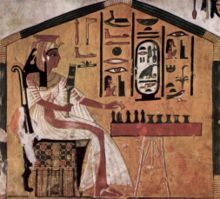Game board

A game board (or gameboard; sometimes, playing board[1] or game map[2]: 25 ) is the surface on which one plays a board game.
The oldest known game boards may date to Neolithic times, however, some scholars argue these may not have been game boards at all. Early Bronze Age artifacts are more universally recognized as game boards (for games such as Egyptian senet and mehen, and the Mesopotamian Royal Game of Ur). Most ancient board games were race games, utilizing random outcome generators like dice.
Game boards evolved in complexity and design, with early examples featuring various shapes before the quadrilateral grid became common for abstract games. They serve as the primary interaction zone for players and can range from simple to highly elaborate, sometimes incorporating three-dimensional or electronic components. Modern board games often illustrated modular or customizable boards, enhancing replay-ability and player engagement.
History

The history of game boards is a topic closely related to

The oldest known game boards were made from stone (game boards made from less durable materials might have existed as well but have not survived until the modern era). Understanding of ancient board games is difficult, as artifacts from such time are often incomplete (smaller accompanying pieces are rarely found), and lack accompanying rules; in many cases even the original name of the game has been lost to time.

Thierry Depaulis has however criticized description of these artifacts as game boards, arguing that they look unpractical for that purpose, no expected gaming pieces nor dice were found to accompany the boards, and the concept of mostly abstract board games was likely too complex for the people of that period. Instead, he suggests those devices were intended for fire making.[10]
Very few if any similar objects have been found in the archeological evidence from sites linked to the Neolithic and
In China, game boards were not often illustrated until around the 19th century.[15]
Board games made in the early 1800s started to feature maps of real locations (ex. Walker's Tour of France from 1815).[5]: 207
The 1963 Mouse Trap is recognized as one of the first mass-produced three-dimensional board games.[16][17]
Characteristics

The game board provides a shared space for the game components and visually communicates some rules to the players.[5]: 2, 304 Most interactions between players in a board game take place on the game board, making it the most important zone of play.[5]: 2, 194 By drawing player attention to itself, the game board is an important part of the "magic circle" (suspension of reality) created by the game.[5]: 2, 194
Game boards have varying level of complexity, abstraction and aesthetics. Some can be very simple (ex. traditional
South Seas)
Some game boards can be quickly improvised using pen and paper or drawn on the ground. Most games use a standardized and unchanging board, usually 
See also
References
- ^ from the original on 2024-06-03. Retrieved 2024-05-15.
- ^ ISBN 978-1-63586-342-0. Archivedfrom the original on 2024-06-03. Retrieved 2024-06-03.
- ^ ISBN 978-0-7864-6797-6. Archivedfrom the original on 2024-06-03. Retrieved 2024-06-03.
- ISBN 978-1-000-29098-1. Archivedfrom the original on 2024-06-03. Retrieved 2024-06-03.
- ^ ISBN 978-1-119-98160-2. Archivedfrom the original on 2024-06-03. Retrieved 2024-06-03.
- ^ a b c Depaulis, Thierry (2021-04-13). "A Timeline of Mind Games, with Some Correlations". BOARD GAME STUDIES COLLOQUIUM- the Evolutions of Board Games, Apr 2021, Paris, France. Archived from the original on 2024-05-14. Retrieved 2024-05-14.
- ^ Stern, Ian (2019). "GAME BOARDS". Excavations at Maresha Subterranean Complex 169: Final Report. Seasons 2000-2016. Vol. XI. p. 127. Archived from the original on 2024-04-23. Retrieved 2024-05-15.
- ^ "Mancala". Savannah African Art Museum. Archived from the original on 3 May 2023. Retrieved 3 May 2023.
- from the original on 2022-06-10. Retrieved 2024-05-14.
- ^ ISSN 2183-3311.
- ISBN 978-1-78649-455-9. Archivedfrom the original on 2024-06-03. Retrieved 2024-06-03.
- ^ Hanussek, Benjamin (2021-01-01). "Transformations into Obscurity: Revisiting the Mehen Board Game and its Unresolved Disappearance in the late 3rd Millennium BC". BGSC/The Evolutions of Board Games: Book of Abstracts. Archived from the original on 2024-06-03. Retrieved 2024-05-14.
- ^ "game-board". British Museum. Archived from the original on 2024-05-15. Retrieved 2024-05-14.
- ISBN 978-0-262-54263-0. Archivedfrom the original on 2024-06-03. Retrieved 2024-06-03.
- from the original on 2024-05-15. Retrieved 2024-05-15.
- ^ "How Toys Changed After World War II". HISTORY. 2022-11-03. Archived from the original on 2024-04-06. Retrieved 2024-05-15.
- ^ "Mouse Trap Game". Victoria and Albert Museum. 1963. Archived from the original on 2024-05-15. Retrieved 2024-05-15.
- from the original on 2024-05-15. Retrieved 2024-05-15.
- ISBN 978-1-003-11030-9. Archivedfrom the original on 2024-05-15. Retrieved 2024-05-15.
- ^ Nichols, Tyler (2013-05-21). "Carcassonne Review". Board Game Quest. Archived from the original on 2024-05-12. Retrieved 2024-05-12.
- ^ Hall, Charlie (2017-08-22). "Star Wars: Legion stole the show at this year's Gen Con". Polygon. Archived from the original on 2024-05-15. Retrieved 2024-05-15.
- ^ Un, Haoran (2016-10-31). "A Board Game Where Everything Is Permanent". Kotaku. Archived from the original on 2023-04-07. Retrieved 2024-05-15.

